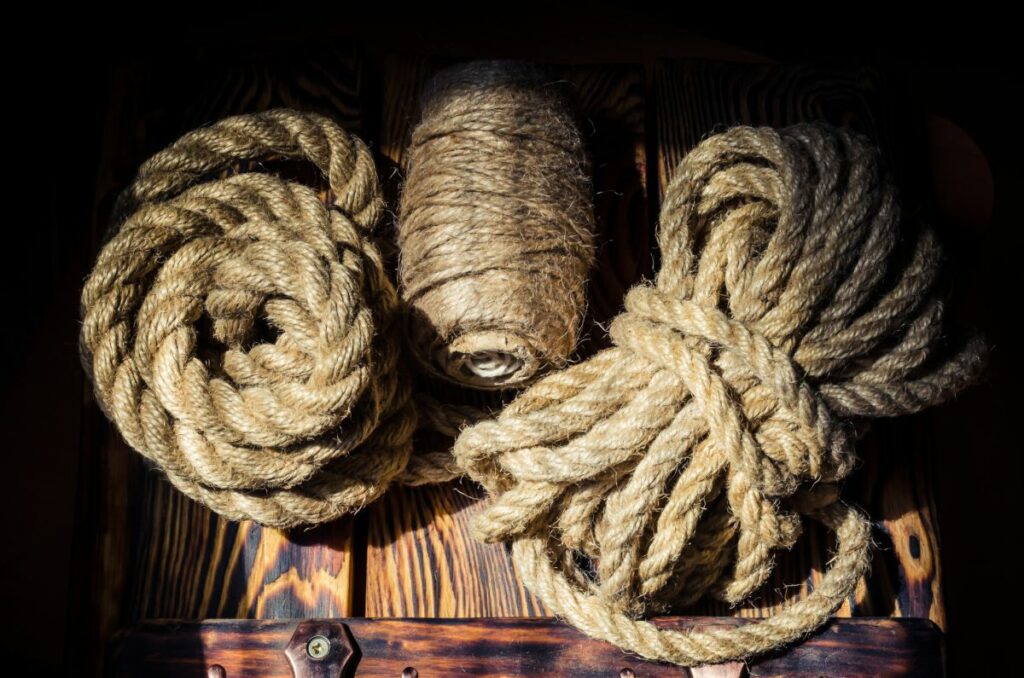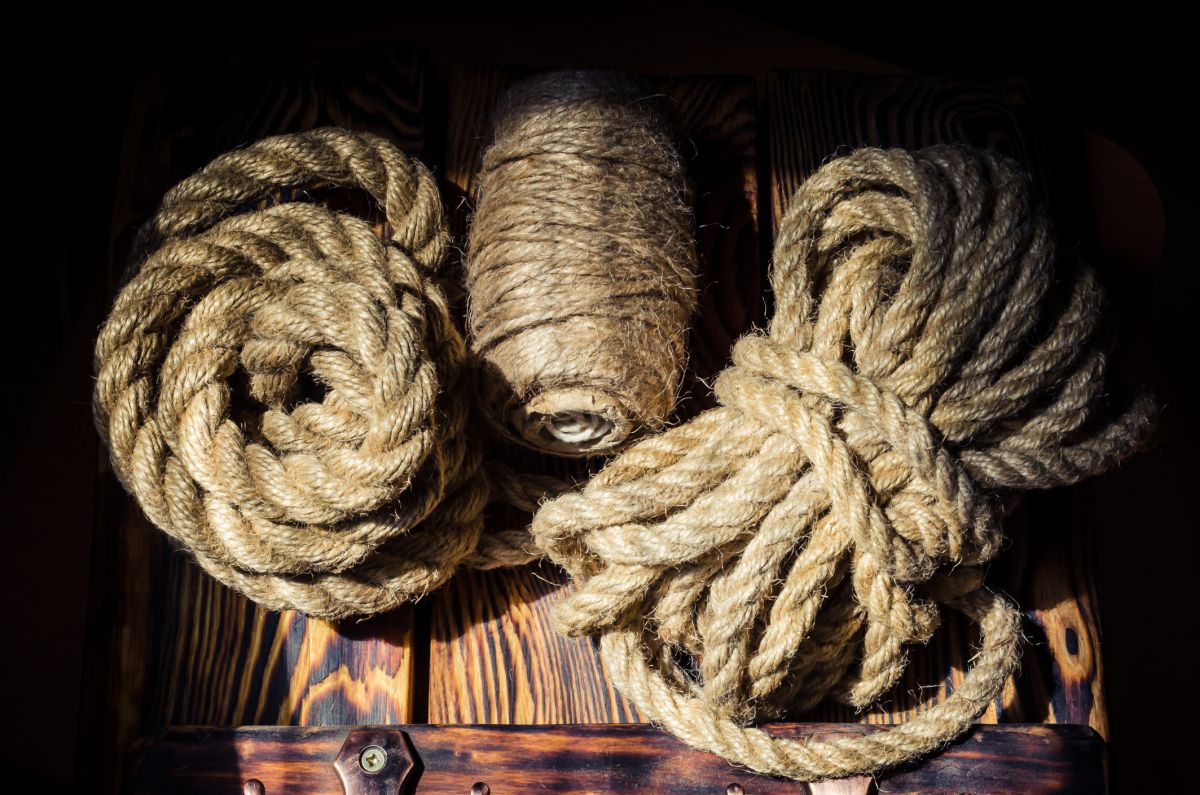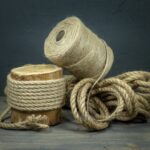Rope was one of the first tools we invented as humans. Rope began as a simple instrument made from plant fibers, mainly used for decoration. As rope became more necessary in our lives, people began inventing different rope patterns and synthetic ropes that are stronger than natural fiber ropes.
Modern rope making is tied to about 7,000 years ago in ancient Asia, Egypt, and Europe. Archaeologists made an astounding discovery a few years ago, proving that ancient civilizations began making ropes 40,000 years ago.
The earliest rope makers used simple tools made from mammoth ivory. Others made simple ropes by weaving the fibers, similar to how they weaved baskets. Soon after, people began using simple rope-making machines with levers. They also crafted ropewalks — long buildings where skilled rope-makers made ropes by hand. Today, most ropes are made on an industrial level using machines, but a few skilled craftsmen keep traditional rope-making alive.

We crafted rope from whatever plant fibers we had available in our areas for the longest time. Some people still craft natural ropes from materials like cotton, jute, sisal, manila, hemp, and coir. Today, we’ve added synthetic materials like wire, polyester, polypropylene, polyethylene, and nylon.
We use rope for many things, including decoration, crafting, boating and marine applications, construction and industrial applications, exercise, gardening, and camping, among many others.
What Is Rope & Its History?
Rope combines fibers, filaments, or wires woven together in twists, braids, or plaits. Ropes are thicker and stronger than strings or fibers alone, making them great for everyday or industrial use.
Rope-Making Started 7,000 Years Ago… Or Is It Much Older?
Rope-making history is ancient, with most historians agreeing that it dates before 4000 BC in Asia. People knew how to create ropes before they learned how to spin or weave yarn, and it was a skill known throughout every civilization in the world.
California State Parks’ Sutter’s Fort State Historic Park describes a brief history of rope:
“Rope was one of humankind’s earliest tools. History records rope making as far back as 7,000 years ago, and is one of America’s oldest industries. The materials that people used to make rope varied and depended on the locality and use of the rope. Rope has been made out of many things: hide, hair, plant fibers, tree bark, cotton wire, silk, and simple vines to name just a few. Twisting or braiding strands of these materials together made them stronger than single untwisted fibers.”
Rope-Making Really Began 40,000 Years Ago
Eberhard Karls Universitat Tubingen’s research states that rope-making is much older, dating around 40,000 years old. An archaeologist from the university discovered a sophisticated tool made from mammoth ivory that our ancestors used to make rope.
The discovery is remarkable because, up until now, we knew almost nothing about the use of rope, textiles, and string by our Paleolithic ancestors. Archaeologists found evidence of string in ancient fired clay, but their use was always tied to decorative use alone.
Researchers from the Eberhard Karls Universitat Tubingen discovered a rope-making tool made from mammoth ivory in the Hohle Fels Cave in southwestern Germany:
“The find is a carefully carved and beautifully preserved piece of mammoth ivory 20.4 cm in length with four holes between 7 and 9 mm in diameter. Each of the holes is lined with deep, and precisely cut spiral incisions. The new find demonstrates that these elaborate carvings are technological features of rope-making equipment rather than just decoration.”
Such instruments were discovered previously but were incomplete and interpreted as artwork, musical instruments, and shaft straighteners. Through rigorous testing, the researchers determined this immaculately preserved specimen was indeed used for rope-making. The discovery links rope-making to as early as 40,000 years ago when humans first arrived in Europe.
Modern Rope-Making
Asia created the first braided ropes before 4000 BC, and Europeans used rope to decorate their pottery around 3000 BC. Around the same time, the Mayans were moving large blocks of stone for their temples with ropes. Around 2500 BC, the ancient Egyptians began creating “modern” ropes, or ropes that we still use today. The Egyptians were also the first civilization to create tools specifically for making rope.
Humans are creative, and we’ve made ropes out of any material we’ve had. The Native Americans created strands from leftover hide and sinew that they twisted into rope. Hair, vines, and plants were also famous for creating ropes.
As rope-making expanded, the craft became more respected. The Romans were the first to fashion ropes out of copper. 14th-century Europeans were the first to establish a rope-makers guild. Rope-making in India was so specialized that only certain citizens were given the job.
Ships Solidified The Importance Of Ropes
Ropes were essential to every civilization long before they began using them for boats. Once people realized how good ropes were for boating, the rope-making industry boomed. Christopher Columbus had 15 miles of rope stored on his ship when he came to America, and the later pioneers brought rope-making machines along on their boats to continue making rope in the new country.
How Did People Create Ropes?
Rope-making machines were not always available throughout history, so people had to make ropes by hand.
Making Ropes By Hand With Simple Machines
Ropes consist of both natural and synthetic fibers. In the ancient world, only natural fibers were available, and people used what materials were available in their area. The most common natural fibers used for ropes are hemp, manila, cotton, jute, sisal, and coir.
People spun plant fibers into twine, which they made into rope. The creation of rope was called “laying.” They pull the twine from a block called a “paddle” until it reaches the desired length. Once the twine was the desired length, they led it to a primitive rope-making machine called a “laying machine.” Then, workers continued this process until the rope was the desired thickness.
Workers needed to choose strings longer than the rope’s desired length when stringing a machine. To begin making the rope, the worker would slide the paddle to the end of the yarns, all of which would have the same tension. The paddle kept the same tension across all the yarn.
Then, a worker begins spinning a handle on the machine counterclockwise. The twisted yarns start to move through the slots in the paddle. Then, the worker would pull the strands further through the spaces while maintaining tension. The rope would be created as the machine spun, although the workers sometimes needed to help the device twist.
Once the rope reached the end of the machine, the worker stopped turning the handle. Then, they moved the yarn from the hooks to a single hook and turned the handle two to three more times to set the rope twisting. The ends of the rope were then removed and tied together.
Creating Rope With Buildings Called “Ropewalks”
In Europe, ropes were created on an industrial scale using buildings called ropewalks. Each community had its own ropemaker who created ropes on a smaller level, and farms usually made their own ropes as well.
Ropewalks were founded in 13th-century Western Europe and began in the United States in Salem, Massachusetts, in 1635. Ropewalks were extended areas in which people would create ropes by walking and twisting them together. The length and capacity of the building determined the length of the rope. Ropewalks were most prevalent along coastal and port towns because ropes were the highest in demand for the fishing and boating industries.
Most ropewalks were slightly over 900 ft, but one building in South England was 2,000 ft long. Ropewalks in rural areas were smaller, while those in the cities were often over 1,000 ft.
Many ropewalks occurred outside, inside buildings, and even on ships. Eventually, people began creating ropewalk sheds over 1,000 ft long and about 30 ft wide. Three to four men made ropes by walking side-by-side while twisting the ropes. Creating ropes in such a fashion was grueling, mainly because the buildings had no heat in winter and no protection from harsh elements.
Eventually, ropewalks made their way out west. Hiram and Alfred Tubbs founded the first ropewalk in San Francisco, California.
Making Ropes With Machines
As the rest of the world progressed, so did ropemaking. People started using machines to make ropes because the process was less grueling and time-consuming than crafting the rope by hand. People continued to hand-make ropes in the Americas until shortly after the Civil War.
Modern-Day Rope Making
Today, ropes are just as important as they ever were, so we must create them on a large scale, but that doesn’t mean traditional rope-making has died.
Most rope is created by machines by large companies like Ellis Ropes Ltd. and Avon Ropes Ltd.
As with any craft, there are still individuals that create ropes by hand, the way people used to. Many of these people run their own small businesses that they mainly operate for fun. You’ll often see these craftsmen demonstrating their process and selling their goods at craft shows.
Heritage museums keep traditional rope-making alive by holding demonstrations and classes for museum-goers to learn rope-making themselves.
What Is Rope Made Of?
Rope material consists of natural or synthetic materials. Natural rope material includes jute, cotton, hemp, sisal, coir, and manila. Synthetic rope material includes wire, polyethylene, polypropylene, nylon, and polyester.
Fibers and strands are woven into patterns to become thick ropes. A rope may be braided, plaited, or twisted. Braided ropes are the strongest, but twisted ropes are better for gripping.
How Is Rope Made?
Nowadays, most people use machines to create ropes, but hand-woven ropes are only partially a thing of the past. Before a person can make a rope, they need to prepare the filaments or fibers. Then, a person or machine spins the fibers to create yarn. Further spinning creates cords that are twisted into strands. Then, someone twists or braids several strands together to make a thick rope.
What Is Rope Used For? (The Most Common Uses)
Since there are so many varieties of natural and synthetic ropes, the uses for ropes are endless. We most often see people using ropes in outdoor settings for camping, boating, or other marine uses, exercise, gardening, or landscaping. Ropes are excellent for creating crafts or decorating the home and are suitable materials for making pet toys. Heavy-duty synthetic ropes are ideal for industrial and construction settings where the ropes are placed under extreme pressure and must bear incredible loads.
FAQs
Which Type Of Rope Consists Of Individual Strands Twisted Together?
The “twisted” rope comprises fibers or filaments that twist around each other. We often see twisted ropes made from natural fibers, but you can also create synthetic ones. Twisted ropes are weaker than braided or plaited ones, but they are better for gripping, so people who handle ropes with their hands prefer them.
What Rope Does Not Stretch?
Cotton is the least stretchy rope out of the natural fibers, but it isn’t strong and doesn’t hold up well outside, so it’s usually only suitable for crafting and decoration. Of the synthetic ropes, polyester is the least stretchy, followed by nylon and polypropylene.
What Is The Best Rope For Tree Climbing?
Those who climb trees professionally use arborist ropes made from nylon or polyester. Polyester and nylon materials are static, not stretchy, which makes for easier climbing. A slight stretch is necessary for these ropes to absorb energy and prevent injury if the tree climber slips.
Arborists often need to pull down trees and use dynamic ropes over static ones. Dynamic ropes can stretch further and are less likely to break under extreme pressure.





